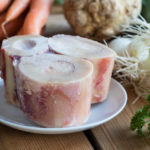Harmony of Religious Values and Paleo: Balancing Religious Restrictions
Last Wednesday while I was flipping through my favorite section of the Times (Dining), I came across an article entitled, “Celebrating Ramadan’s End with Traditional Treats”.[1]
After a few paragraphs which provided a brief history on the month long fasts of Ramadan as well as a couple of peeks into the Muslim-American society in Queens, NY, there’s a recipe for a traditional treat, Muzaffar Seviyan, which is a sweet vermicelli with cardamom.
According to the article, Eid al-Fitr is a holiday dedicated to feasting, which begins the next day and during it, one is encouraged to “eat all the things that are too rich, too sweet and too creamy for a normal day”, according to Sumayya Usmani, who writes the food blog My Tamarind Kitchen.[2]
Food plays a far more complex role in our lives than simply being a source of nutrition that our bodies need, one of them being to play a key role in religious holidays, ceremonies and traditions.
And unlike making a modification at a restaurant simply because you choose to follow a gluten free eating regime and ask for extra broccoli to replace the pasta, it can be quite a bit trickier to incorporate your Paleo eating when you’re factoring in the weight of the spiritual significance.
Under certain situations it’s easy enough to avoid foods, such as if one’s religion prevents the consumption of a certain food.
Take pork, for example.
According to Jewish law, pork is one of a number of foods forbidden to Jews. These foods are known as “non-kosher” foods. In order for meat to be kosher, it must first come from a kosher animal. A kosher animal must be a ruminant and have split hooves; therefore, cows, sheep, goats and deer are all kosher, whereas pigs are not kosher.[3]
In this case, it’s a simple matter of just not eating the pork.
Where it gets really complicated is when there are certain foods that are meant to be eaten for religious reasons, which one strongly prefers not to consume.
The Holy Eucharist is the true Body & Blood of Christ. Catholics call this process Transubstantiation, in which the Holy Spirit changes the essence of the substance into the Body & Blood of Christ, the substance being bread and wine[4].
So what does one do if they’ve learned that they have Celiac Disease? Simply saying, “no thanks”, isn’t exactly an option.
Interestingly, a group of resourceful nuns, the Benedictine sisters in Clyde, Missouri, attempted to remedy the situation by making low-gluten wafers, which contain slightly more wheat than true gluten-free products but the Vatican found them unacceptable, ABC News reports[5].
In 2012, the U.S. Conference of Catholic Bishops wrote “it is impossible to consecrate a host made of something other than wheat and water.” (The reason: Jesus ate wheat bread with his apostles during the Last Supper.)
Even if low-gluten foods were an option for someone with Celiac Disease, which they’re not, they wouldn’t fit the bill from a religious standpoint.
So what’s the answer? How can we navigate through a religious holiday if it means eating foods we’ve found make us ill?
It comes down to finding your own balance of which foods you may be able to partake of, perhaps just in moderation versus those which you simply cannot handle as well as honoring your own beliefs.
Fanesca is a soup eaten during Holy Week in Ecuador, containing twelve types of beans representing the Apostles and salt cod representing Jesus Christ[6].
If you’ve been following a Paleo regime and do feel better avoiding beans, yet eating them now and then doesn’t seem to bother you, and you happen to celebrate this holiday, perhaps your best bet is to go ahead and partake, unlike in the example above with avoiding a wafer due to having Celiac disease.
Just as everyone’s belief system, faith and degree to which they practice religious custom varies so widely, so too do the ways one might navigate their holidays.
Do your best to avoid foods that make you feel unhealthy when possible, incorporate just a taste, perhaps, in the event that that alone will demonstrate the act in which you’re partaking, and enjoying the foods wholeheartedly that both allow you to be a part of the custom and nourish your body and soul simultaneously.
[1] Moskin, Julia. “Celebrating Eid Al-Fitr, the End of Ramadan, With Sweet, Traditional Treats.” The New York Times. The New York Times, 14 July 2015. Web. 21 July 2015.
[2] http://www.mytamarindkitchen.com
[3] “Soul Food The Jewish Dietary Laws”. Kashrut.com. 1999-02-06. Retrieved 2012-09-14
[4] Encyclopædia Britannica, s.v. Eucharist
[5] “Why the Catholic Church Frowns Upon Gluten-Free Communion Wafers.” Health News / Tips & Trends / Celebrity Health. N.p., 22 Oct. 2014. Web. 21 July 2015
[6] Calvin Trillin, “Speaking of soup”, The New Yorker, 5 September 2005





